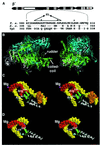Structure-based analysis of RNA polymerase function: the largest subunit's rudder contributes critically to elongation complex stability and is not involved in the maintenance of RNA-DNA hybrid length
- PMID: 11889042
- PMCID: PMC125355
- DOI: 10.1093/emboj/21.6.1369
Structure-based analysis of RNA polymerase function: the largest subunit's rudder contributes critically to elongation complex stability and is not involved in the maintenance of RNA-DNA hybrid length
Abstract
Analysis of multisubunit RNA polymerase (RNAP) structures revealed several elements that may constitute the enzyme's functional sites. One such element, the 'rudder', is formed by an evolutionarily conserved segment of the largest subunit of RNAP and contacts the nascent RNA at the upstream edge of the RNA-DNA hybrid, where the DNA template strand separates from the RNA transcript and re-anneals with the non-template strand. Thus, the rudder could (i) maintain the correct length of the RNA-DNA hybrid; (ii) stabilize the nascent RNA in the complex; and (iii) promote or maintain localized DNA melting at the upstream edge of the bubble. We generated a recombinant RNAP mutant that lacked the rudder and studied its properties in vitro. Our results demonstrate that the rudder is not required for establishment of the upstream boundary of the transcription bubble during promoter complex formation, nor is it required for separation of the nascent RNA from the DNA template strand or transcription termination. Our results suggest that the rudder makes critical contributions to elongation complex stability through direct interactions with the nascent RNA.
Figures






Similar articles
-
The role of the largest RNA polymerase subunit lid element in preventing the formation of extended RNA-DNA hybrid.J Mol Biol. 2006 Aug 25;361(4):634-43. doi: 10.1016/j.jmb.2006.05.034. Epub 2006 Jun 5. J Mol Biol. 2006. PMID: 16781733
-
A structural model of transcription elongation.Science. 2000 Jul 28;289(5479):619-25. doi: 10.1126/science.289.5479.619. Science. 2000. PMID: 10915625
-
Structure-function analysis of the RNA polymerase cleft loops elucidates initial transcription, DNA unwinding and RNA displacement.Nucleic Acids Res. 2008 Feb;36(2):676-87. doi: 10.1093/nar/gkm1086. Epub 2007 Dec 10. Nucleic Acids Res. 2008. PMID: 18073196 Free PMC article.
-
The role of the lid element in transcription by E. coli RNA polymerase.J Mol Biol. 2006 Aug 25;361(4):644-58. doi: 10.1016/j.jmb.2006.06.071. Epub 2006 Jul 27. J Mol Biol. 2006. PMID: 16876197
-
Hold on!: RNA polymerase interactions with the nascent RNA modulate transcription elongation and termination.RNA Biol. 2010 May-Jun;7(3):310-5. doi: 10.4161/rna.7.3.11912. Epub 2010 May 26. RNA Biol. 2010. PMID: 20473037 Free PMC article. Review.
Cited by
-
Bacterial global regulators DksA/ppGpp increase fidelity of transcription.Nucleic Acids Res. 2015 Feb 18;43(3):1529-36. doi: 10.1093/nar/gkv003. Epub 2015 Jan 20. Nucleic Acids Res. 2015. PMID: 25605801 Free PMC article.
-
RNA polymerase active center: the molecular engine of transcription.Annu Rev Biochem. 2009;78:335-61. doi: 10.1146/annurev.biochem.76.052705.164655. Annu Rev Biochem. 2009. PMID: 19489723 Free PMC article. Review.
-
The σ70 region 1.2 regulates promoter escape by unwinding DNA downstream of the transcription start site.Nucleic Acids Res. 2013 Apr;41(8):4565-72. doi: 10.1093/nar/gkt116. Epub 2013 Feb 20. Nucleic Acids Res. 2013. PMID: 23430153 Free PMC article.
-
Recent advances in mycobacterial transcription: insights beyond the general pathway.J Bacteriol. 2025 Jul 24;207(7):e0015425. doi: 10.1128/jb.00154-25. Epub 2025 Jun 24. J Bacteriol. 2025. PMID: 40552809 Free PMC article. Review.
-
Structural perspective on mutations affecting the function of multisubunit RNA polymerases.Microbiol Mol Biol Rev. 2006 Mar;70(1):12-36. doi: 10.1128/MMBR.70.1.12-36.2006. Microbiol Mol Biol Rev. 2006. PMID: 16524917 Free PMC article. Review.
References
-
- Allison L.A., Moyle,M., Shales,M. and Ingles,C.J. (1985) Extensive homology among the largest subunits of eukaryotic and prokaryotic RNA polymerases. Cell, 42, 599–610. - PubMed
-
- Borukhov S. and Goldfarb,A. (1993) Recombinant Escherichia coli RNA polymerase: purification of individually overexpressed subunits and in vitro assembly. Protein Expr. Purif., 4, 503–511. - PubMed
-
- Burgess R.R., Arthur,T.M. and Pietz,B.C. (1998) Interaction of Escherichia coli σ70 with core RNA polymerase. Cold Spring Harb. Symp. Quant. Biol., 63, 277–287. - PubMed
-
- Chamberlin M.J. (1992) New models for the mechanism of transcription elongation and its regulation. Harvey Lect., 88, 1–21. - PubMed
-
- Cramer P., Bushnell,D.A. and Kornberg,R.D. (2001) Structural basis of transcription: RNA polymerase II at 2.8 Å resolution. Science, 292, 1863–1876. - PubMed
Publication types
MeSH terms
Substances
Grants and funding
LinkOut - more resources
Full Text Sources
Other Literature Sources

